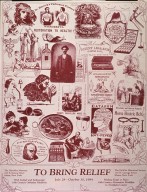
Introduction: As professional medicine began to organize itself by setting educational requirements and by forming professional societies, cultural ideas consolidated about women as biologically inferior people destined to reproduce and raise children, remaining in the home while men worked (known as separate spheres ideology). Together, these medical and social ideas kept women out of the medical profession. The Declaration of Sentiments establishes context; Elizabeth Cady Stanton succinctly lists the rights and opportunities that are denied to women. In another chapter of A Midwife's Tale, we see two doctors competing with Martha Ballard's well-established practice of midwifery by using the medical procedure of dissection. In an 1820 pamphlet, Dr. Walter Channing gives explicit reasons for the medical profession to stop women from performing their traditional midwifery. In a later chapter of The Birth House, Dr. Thomas appeals to townswomen to have their babies in his modern hospital. Not only did doctors seek to take over women's healing practices, but also they provided medical evidence of women's supposed inferiority to men. Smith-Rosenberg and Rosenberg's "The Female Animal" discusses the nineteenth-century theory that women were intellectually and socially inferior because their reproductive systems were unpredictable and caused illness and weakness. Finally, at this time, physicians were competing with an array of alternative and patent medicines available to the public for self-treatment, some of which are illustrated in advertisements in the poster "To Bring Relief."
Primary:
- Channing, Walter. Remarks on the employment of females as practitioners in midwifery. Boston: Cummings and Hilliard, 1820. Available online at //resource.nlm.nih.gov/2545065R.
- McKay, Ami. The Birth House: A Novel. New York: Harper, 2006, Chap. 15.
- Stanton, Elizabeth Cady. "The Declaration of Sentiments." 1848. Available online at //www.america.gov/st/pubs-english/2005/May/20050531160341liameruoy0.2459375.html. (accessed 11/26/2012).
- Ulrich, Laurel Thatcher. A Midwife's Tale: The Life of Martha Ballard, Based on Her Diary, 1785-1812. New York: Vintage, 1991, Chap. 7.
Secondary:
- Smith-Rosenberg, Carroll and Charles E. Rosenberg. "The Female Animal: Medical and Biological Views of Woman and Her Role in Nineteenth-Century America." In Women and Health in America: Historical Readings. Second edition. Edited by Judith Walzer Leavitt. Madison: University of Wisconsin Press, 1999, Chap. 6.
Image:
 The Hickley Museum. TO BRING RELIEF With scalpel and stethoscope: 19th Century Orthodox Medicine; Without Knife or pain: 19th-Century Alternative Medicine in Tompkins County. Poster. Ithaca, N.Y: Hinckley Museum, 1984.
The Hickley Museum. TO BRING RELIEF With scalpel and stethoscope: 19th Century Orthodox Medicine; Without Knife or pain: 19th-Century Alternative Medicine in Tompkins County. Poster. Ithaca, N.Y: Hinckley Museum, 1984.
- For Stanton: Describe or summarize what rights and opportunities were denied to women in the 1840s, according to Stanton's list of facts.
- For Ballard: Why are men only allowed to perform the dissection on John Davis? How are moral propriety and medical expertise gendered?
- Putting Ballard together with Smith-Rosenberg and Rosenberg, what ideas about women—their minds and their bodies—are generating the belief that they cannot or should not engage in medical education and medical procedures, even though they have been performing the care of the sick and birthing in their communities for centuries?
- Compare Ballard and Channing. What are some important differences between women's healing practices and male doctors' treatments? In what specific ways do Drs. Page and Colman, and Dr. Channing exclude women from their profession? Why do they define medical professionalism as a male activity or identity?
- In The Birth House: What are some conflicts over child delivery practices between Dr. Thomas and the midwives, Miss Barbineau and Dora? What reasoning does Dr. Thomas use to encourage women to seek medical attention for childbirth and avoid midwives (such as pain, law, modern treatment)?
- For poster "To Bring Relief": What kinds of remedies are for sale? What do the remedies tell us about how nineteenth-century people thought about illness and health?
Students work together to identify a woman physician for the biography project to research in a local archive. They may choose a nineteenth-century physician from the Changing the Face of Medicine site, or a physician using the catalog of a school's archive, a city, state or federal archive, a local historical society or museum, or a public library. In selecting a physician, students evaluate whether there are sufficient local or online materials. If not, they may have an option to conduct research on secondary sources about a physician with a reference librarian's help. Alternatively, the course instructor can identify and assign a physician for whom sufficient materials are available and accessible to students.
The selected woman physician's life can be divided into several segments in chronological order. Students, working individually or in small groups, are assigned a segment to write. They assemble their segments to produce the physician's biography as a class.
Students prepare for the next class by reviewing the questions they generated during discussion of the Ulrich and Fett readings in Class 1.














